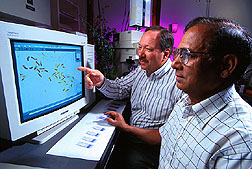A Gene Map for Alfalfa
Alfalfa is called Queen of the Forages because of the many nutritional benefits it offers dairy cows and other farm animals. Now, plant scientists are closing in on the genetic secrets behind its success as America s fourth largest crop--after corn, soybeans, and wheat.
At the Soybean and Alfalfa Research Laboratory in Beltsville, Maryland, geneticist Gary R. Bauchan and visiting scientist M. Azhar Hossain have devised a new computer imaging technique offering the closest look yet at the 32 chromosomes that house the legume's genes.
The advance is casting new light on alfalfa's complex genetic makeup. And it bodes well for breeders looking to incorporate new traits from wild species into cultivated alfalfa, which is valued at $6.4 billion annually, primarily as hay.
Unlike corn or soybeans, alfalfa plants are autotetraploid; that is, each trait is determined by genes residing in four chromosomes instead of two. "That makes genetics research very complex and adds to the difficulty of improving alfalfa," notes Bauchan.
Over the past 30 years, average alfalfa yield has increased by roughly 1 percent, whereas corn, soybeans, and wheat have enjoyed far greater gains.
"Alfalfa," says Bauchan, "is kind of the forgotten crop because very little is consumed directly by people." Another obstacle: Alfalfa's chromosomes are comparatively smaller--barely visible under a microscope and hard to distinguish from one another.
Bauchan and Hossain have tackled this problem by attaching a special computer imaging system to a light microscope. Loats Associates, a Maryland image analysis company, helped devise the system, which uses chromosomes extracted from root tips.
By converting the microscope's image into pixels, the computer can increase magnification 10,000-fold. And, it can add pseudo-coloring to show the chromosomes features better. That's helped scientists observe banding patterns and for the first time, make accurate measurements of the chromosomes' length. Both are key to karyotyping, or arranging matching pairs from the largest (3 microns) to smallest (2 microns).
"By combining the techniques of chromosome banding and image analysis, we've begun to unfold some of the mysteries of alfalfa's complex genome," says Hossain.
For example, along the "arms" of certain alfalfa chromosomes scientists identified thick bands of DNA and protein material called heterochromatin. Like chromosomal roadblocks, the bands can impede the free exchange of genes between parent plants or different alfalfa species.
"What we've discovered," says Bauchan, "is that some yellow-flowered (Falcata) alfalfas, which carry genes for winter hardiness, stand persistence, and resistance to bacterial wilt, have a lower amount of heterochromatin than some of the standard, purple-flowered alfalfas." This suggests that breeders could use certain Falcata types to shuttle, or transfer, desirable new traits from wild alfalfas into cultivated varieties that normally wouldn't accept such exchanges directly.
Falcata is an excellent candidate because it is one of the nine major germplasm introductions from which today's alfalfa varieties are derived. Wild alfalfa species offer a source of genetic replenishment.
To that end, the heterochromatin bands can serve as handy benchmarks to flag important genes, such as those for improved yield. One goal, says Bauchan, "is to develop a chromosome map showing where the genes are located on the chromosomes."
So far, scientists have isolated relatively few alfalfa genes. But "once you put a benchmark on a chromosome," Bauchan says, "then you start looking at what's next to it."—By Jan Suszkiw, Agricultural Research Service Information Staff.
This research is part of Crop Production, Product Value, and Safety, an ARS National Program described on the World Wide Web at http://www.nps.ars.usda.gov/programs/cppvs.htm.
Gary R. Bauchan and M. Azhar Hossain are at the USDA-ARS Soybean and Alfalfa Research Laboratory, Bldg. 006, Room 14, 10300 Baltimore Ave., Beltsville, MD 20705-2350; phone (301) 504-6649, fax (301) 504-5728.
"A Gene Map for Alfalfa" was published in the August 1999 issue of Agricultural Research magazine.







